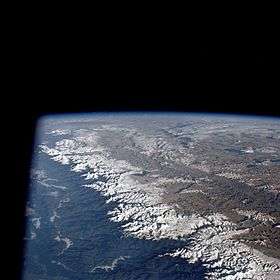Himalayan states
The Himalayan states are a group of countries straddling the Himalayan mountain range in Asia. The area is divided between the Western Himalaya and the Eastern Himalaya. Two sovereign states, Nepal and Bhutan, are located almost entirely within the mountain range. The range also covers southern Tibet, the Indian Himalayan states of North and Northeast India and northern Pakistan.[1] Eastern Afghanistan and Northern Myanmar are sometimes also included.[2][3]
| Himalayan states and regions | |
 | |
| Countries | |
The inhabitants of this region are mostly speakers of Indo-Aryan and Tibeto-Burman languages,[4] while the main religions are Buddhism, Hinduism and Islam.
Some of the world's major trans-boundary rivers originate in the Himalayas, including the Indus, Ganges, Brahmaputra and Irrawaddy.[5]
See also
References
- Bishop, Barry. "Himalayas (mountains, Asia)". Encyclopædia Britannica. Retrieved 5 June 2016.
- "The Himalayas". PBS. 11 February 2011. Retrieved 11 February 2011.
- "Myanmar Himalaya Travel".
- Chatterjee, Shiba. "Himalayas (mountains, Asia)". Encyclopædia Britannica. Retrieved 5 June 2016.
- Wirsing, R.; Jasparro, C.; Stoll, D. (16 November 2012). International Conflict over Water Resources in Himalayan Asia - R. Wirsing, C. Jasparro, D. Stoll - Google Books. ISBN 9781137292193. Retrieved 22 May 2016.